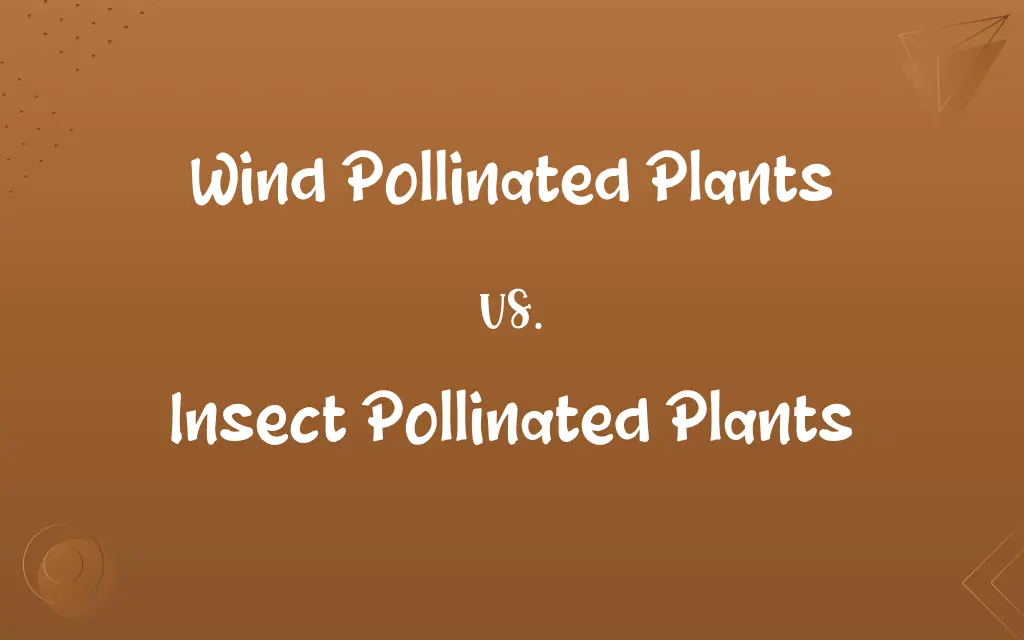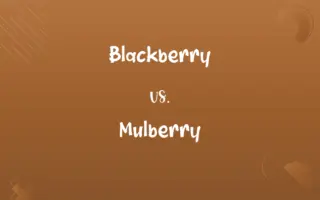Wind Pollinated Plants vs. Insect Pollinated Plants: Know the Difference

By Dua Fatima & Shumaila Saeed || Published on April 1, 2024
Wind-pollinated plants rely on air to disperse pollen, often having inconspicuous flowers, while insect-pollinated plants have colorful, fragrant blooms to attract pollinators, facilitating direct pollen transfer.

Key Differences
Wind-pollinated plants have evolved to optimize pollen dispersal through the air, resulting in features like long stamens and pistils, and a lack of nectar and scent, as these traits are unnecessary for attracting insects. Conversely, insect-pollinated plants exhibit vibrant colors, distinct fragrances, and nectar to attract specific pollinators, which ensures efficient and targeted pollen transfer from one flower to another.
Shumaila Saeed
Apr 01, 2024
The flowers of wind-pollinated plants are usually smaller, less colorful, and produce a large quantity of lightweight pollen to increase the chances of successful pollination. This contrasts with insect-pollinated plants, which produce pollen that is stickier and heavier, designed to adhere to the bodies of insects as they move from flower to flower, a mechanism that significantly reduces the waste of pollen.
Dua Fatima
Apr 01, 2024
Wind-pollinated species, such as many grasses, grains, and trees, are often less dependent on specific pollinator species, which can make them more resilient in various environments. Insect-pollinated plants, however, can form symbiotic relationships with their pollinators, leading to a mutual dependence that enhances the survival and reproduction of both the plant and the insect species.
Dua Fatima
Apr 01, 2024
Environmental conditions influence the efficiency of both pollination strategies. Wind pollination can be more unpredictable and less efficient in terms of pollen use, as it relies on the presence of wind for dispersal. Insect pollination, while more energy-intensive for the plant due to the production of nectar and pigments, can be more precise, leading to higher rates of successful pollination.
Hifza Nasir
Apr 01, 2024
The adaptations of plants to their pollination methods highlight the diversity of strategies in the plant kingdom for reproduction. While wind-pollinated plants prioritize broad dispersal to ensure pollination success, insect-pollinated plants invest in features that attract specific pollinators, demonstrating the intricate relationships between plants and their environment.
Dua Fatima
Apr 01, 2024
ADVERTISEMENT
Comparison Chart
Flower Characteristics
Small, inconspicuous, no fragrance
Colorful, fragrant, often large
Dua Fatima
Apr 01, 2024
Pollination Strategy
Relies on wind for pollen dispersal
Utilizes insects for direct pollen transfer
Dua Fatima
Apr 01, 2024
Dependence on Pollinators
Low; does not require specific pollinators
High; often relies on specific insect species
Hifza Nasir
Apr 01, 2024
Efficiency and Precision
Less efficient and less precise
More efficient and precise
Hifza Nasir
Apr 01, 2024
ADVERTISEMENT
Wind Pollinated Plants and Insect Pollinated Plants Definitions
Wind Pollinated Plants
They typically have long stamens and pistils.
Wheat flowers extend their stamens to catch the wind.
Dua Fatima
Feb 29, 2024
Insect Pollinated Plants
Depend on insects for efficient pollen transfer.
Blueberries are pollinated by bees visiting each flower for nectar.
Shumaila Saeed
Feb 29, 2024
Wind Pollinated Plants
Adapted for pollination without animal assistance.
Corn is efficiently pollinated by wind, distributing pollen from tassel to silk.
Dua Fatima
Feb 29, 2024
Insect Pollinated Plants
Insect-pollinated plants have colorful, fragrant flowers.
Roses attract bees with their vivid colors and sweet scent.
Dua Fatima
Feb 29, 2024
Wind Pollinated Plants
Wind-pollinated plants produce large amounts of lightweight pollen.
Grasses rely on wind to spread their pollen to other plants.
Shumaila Saeed
Feb 29, 2024
ADVERTISEMENT
Insect Pollinated Plants
Designed to attract specific pollinators.
Orchids mimic the appearance of female insects to lure in males for pollination.
Dua Fatima
Feb 29, 2024
Wind Pollinated Plants
Their flowers lack nectar and scent.
Oak trees have inconspicuous flowers that do not attract insects.
Shumaila Saeed
Feb 29, 2024
Insect Pollinated Plants
They produce sticky, heavy pollen.
Tomato plants have pollen that sticks to bees for transfer to other flowers.
Shumaila Saeed
Feb 29, 2024
Wind Pollinated Plants
Often found in open or windy environments.
Pine trees release clouds of pollen into the air for wind dispersal.
Shumaila Saeed
Feb 29, 2024
Insect Pollinated Plants
Often involve mutualistic relationships.
The relationship between butterflies and lavender benefits both species.
Dua Fatima
Feb 29, 2024
Repeatedly Asked Queries
What are the main characteristics of insect-pollinated plants?
Insect-pollinated plants are characterized by their colorful and fragrant flowers, which are designed to attract specific insects.
Dua Fatima
Apr 01, 2024
How do insects contribute to the pollination of plants?
Insects transfer pollen directly from one flower to another as they move between plants, facilitating efficient and targeted pollination.
Shumaila Saeed
Apr 01, 2024
What is wind pollination?
Wind pollination is a process where plants rely on the wind to disperse their pollen to other plants for fertilization.
Shumaila Saeed
Apr 01, 2024
Can a plant be both wind and insect-pollinated?
While most plants specialize in one method, some plants can utilize both wind and insect pollination to maximize their reproductive success.
Dua Fatima
Apr 01, 2024
Why do wind-pollinated plants produce more pollen?
They produce more pollen to increase the chances of successful pollination due to the indiscriminate nature of wind dispersal.
Dua Fatima
Apr 01, 2024
Why are flowers of wind-pollinated plants less colorful?
Because they do not need to attract pollinators, these plants invest less in visual and olfactory cues, focusing resources on pollen production.
Shumaila Saeed
Apr 01, 2024
What advantages do insect-pollinated plants have?
They benefit from more precise and efficient pollination, which can lead to higher fertilization rates and genetic diversity.
Hifza Nasir
Apr 01, 2024
How do environmental factors affect these two pollination strategies?
Wind pollination can be affected by weather conditions, while insect-pollinated plants may be impacted by the availability of their pollinators.
Shumaila Saeed
Apr 01, 2024
Is one pollination method better than the other?
Neither method is inherently better; each has evolved to suit the specific needs and environmental conditions of the plant species.
Shumaila Saeed
Apr 01, 2024
How do pollination strategies influence plant biodiversity?
Pollination strategies contribute to the diversity of plant forms and behaviors, influencing their distribution, evolution, and ecosystem roles.
Dua Fatima
Apr 01, 2024
Share this page
Link for your blog / website
HTML
Link to share via messenger
About Author
Written by
Dua FatimaCo-written by
Shumaila SaeedShumaila Saeed, an expert content creator with 6 years of experience, specializes in distilling complex topics into easily digestible comparisons, shining a light on the nuances that both inform and educate readers with clarity and accuracy.








































































